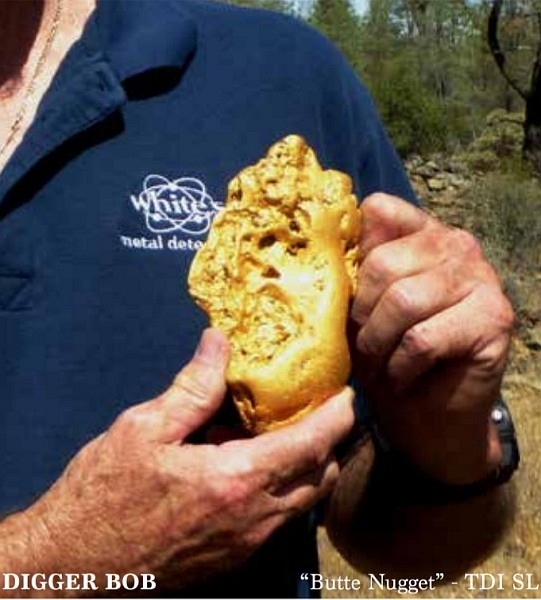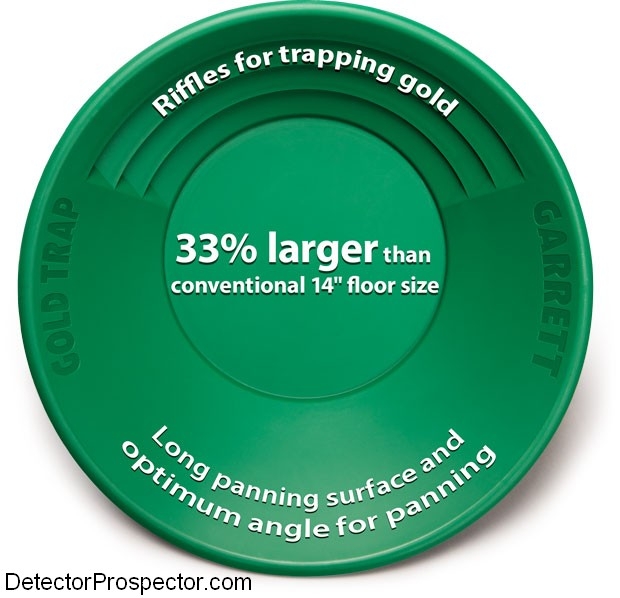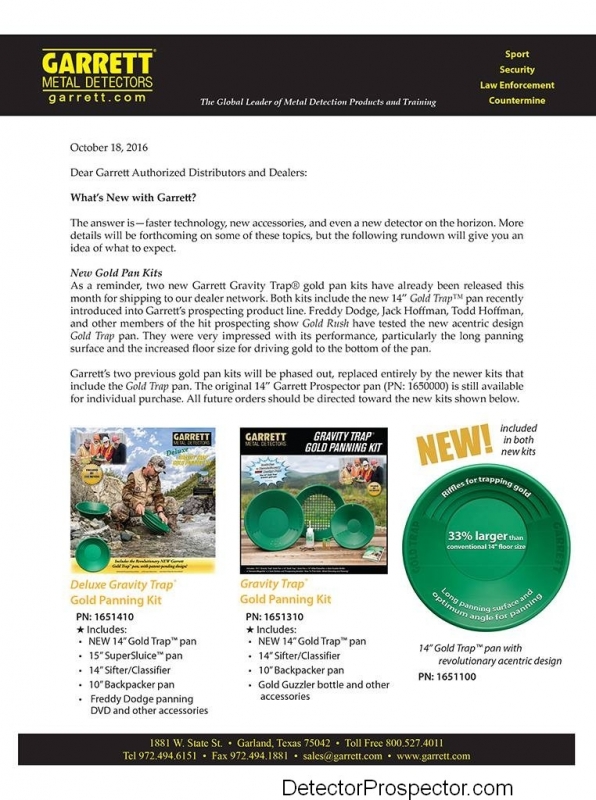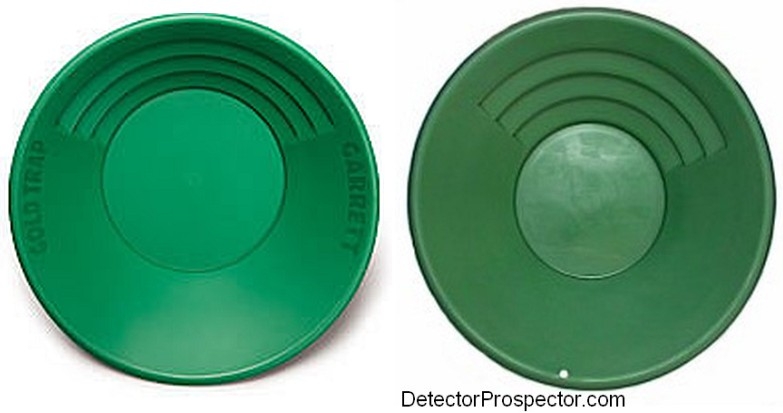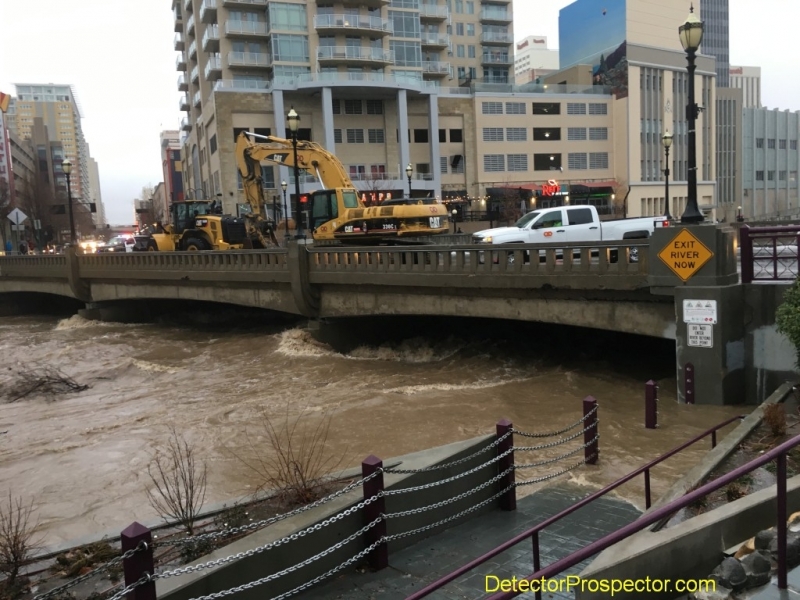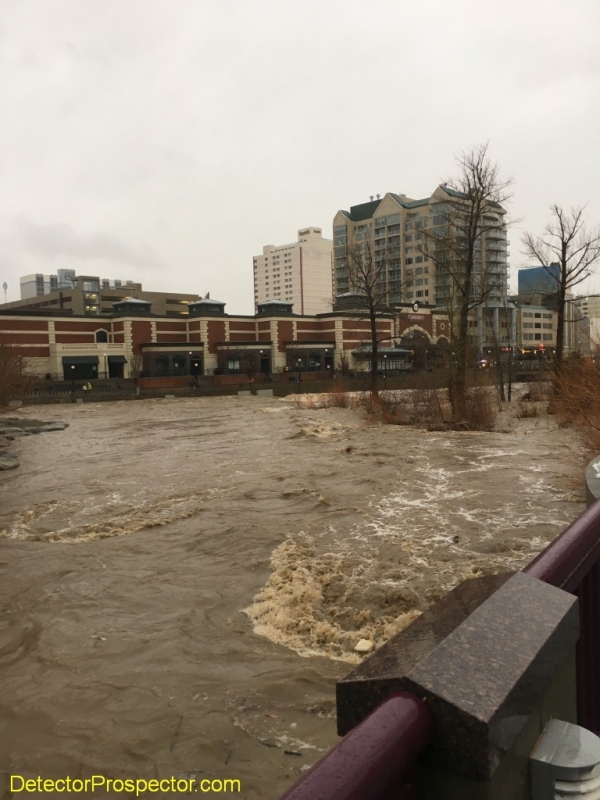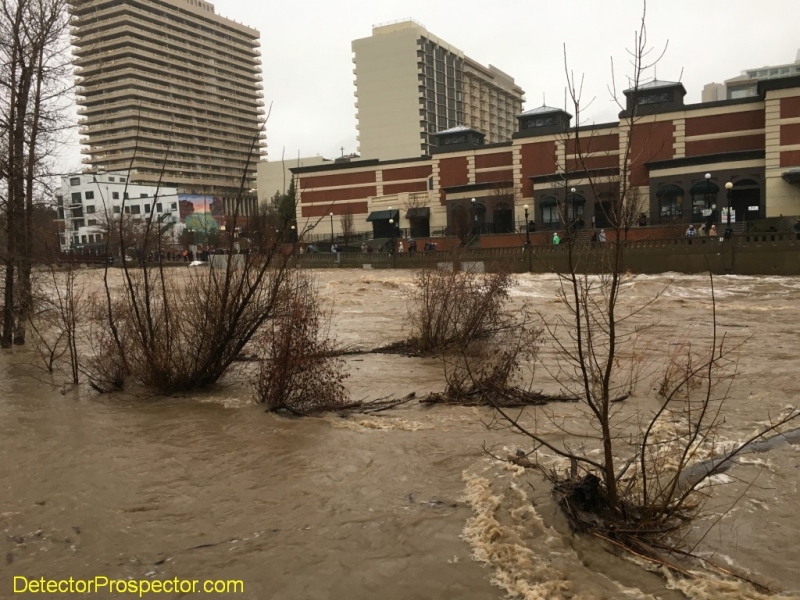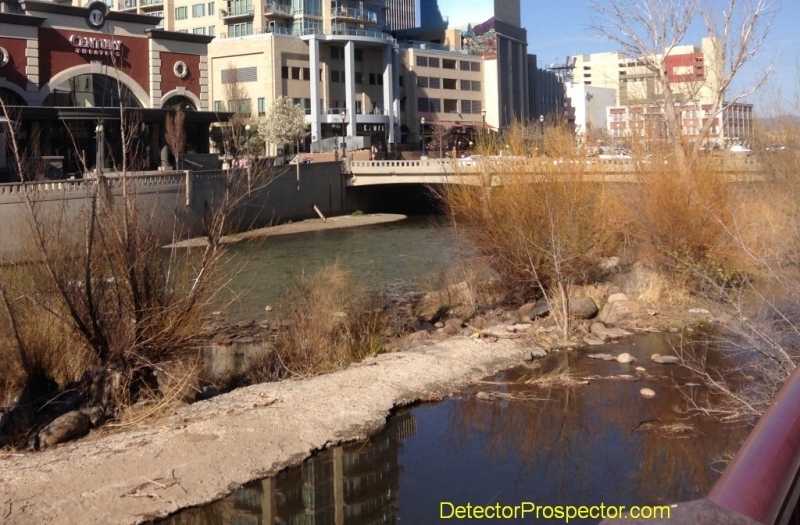-
Posts
19,751 -
Joined
Content Type
Forums
Detector Prospector Home
Detector Database
Downloads
Everything posted by Steve Herschbach
-

California Flooding?
Steve Herschbach replied to Reno Chris's topic in Gold Panning, Sluicing, Dredging, Drywashing, Etc
-

The Best Coil For The MX Sport?
Steve Herschbach replied to gramps green's topic in White's Metal Detectors
That is of course just a matter of opinion. Mine is that I would use the stock coil. Runner up, 7" DeTech coil. -

Back Again - White's Discover Magazine!
Steve Herschbach replied to Steve Herschbach's topic in White's Metal Detectors
Remember back in 2014 when that massive five pound gold nugget was found in California - the Butte Nugget? At the time what detector it was found with was shrouded in mystery. Maybe the detector model was revealed at a later date and I just missed it. Regardless, this issue of Discover just cleared the mystery up.... -

First Hunt For 2017 , Skunked First Day !
Steve Herschbach replied to Squizz's topic in Detector Prospector Forum
Use the edit function in the post. -
I would add to the above that if you lack the mentioned expertise - hire a qualified person that does. Best insurance money you will ever spend! There are companies that will file all the appropriate paperwork each year, etc. I filed my own paperwork for decades and still managed to screw it up finally so even people that think they know how can get caught. Arizona has a page on mining scams at http://www.azgs.az.gov/mining_scams.shtml More from http://dnr.alaska.gov/mlw/factsht/mine_fs/investig.pdf (on Alaska mining claims but similar issues apply elsewhere): ASK THE SELLER: 1. Is the claim State or Federal? What is the claim name and number? If it is a state claim ask for the ADL (Alaska Division of Lands) number. This is the identifying number for state records regarding the claim, and will help you research claim history, status, staking and maintenance. 2. Who is the owner of record? Claims can have more than one owner. In such cases, remember if only the interest of one owner is being transferred, you will be a partner with other owners of record. 3. Ask for a recorded copy of the claim location certificate. A recorded copy of the claim location certificate will have on it the Recording District Office stamp, date of recording, and document number or book and page number. 4. Whether Annual Labor or assessment work has been accomplished on a continuing basis; was acceptable; and has been properly recorded and filed according to State or Federal regulations. (NOTE: Again, regulations vary considerably here! Detailed information can be obtained by contacting the appropriate information source for State and Federal claims.) ***Be careful of claims offered for sale after September 1. This is the end of the annual labor year on both State and Federal claims. Assessment work must have been accomplished for any specific year prior to that date and recorded no later than November 30th for the State claims and December 30th for Federal claims. Have the seller show you a properly recorded affidavit. 5. Whether the claim is in conflict with other mineral locations. Claim conflicts do occur and often end up in court when the parties involved cannot resolve the problem themselves. You should verify the answers to the above questions through your own research or by engaging a professional agent to help guide you through the claim purchase. Other factors can enter into claim validity – factors that are often challenged in a court of law, especially if claim conflicts exist. These may include: 1. Whether the claim was located following the guidelines of appropriate State or Federal regulations, including: • Whether a “discovery” of a locatable mineral actually took place. The seller should be able to prove what type of discovery took place, i.e. geochemical sampling, panning, or drilling. If a visit to the location is possible, obtain permission to do your own sampling. • Whether the claim was actually staked in the field. Were posts or monuments erected and notice posted according to law? Or, was the claim “paper-staked”? • Whether the claim was properly recorded within 45 days of the date of staking in the District Recorder’s Office where it was located. 2. Whether annual labor has been done and properly recorded. Errors in the “essential facts” required on the annual labor affidavit are grounds for abandonment of the claim. 3. Whether annual rental has been paid in a timely manner. On State mining claims the rental year begins at noon on September 1 and ends at noon on September 1 of the following year. Payments must be received no later than November 30 of the same year. The penalty for failure to make a timely payment is abandonment of the location. See the Annual Rental Fact Sheet available on the Mining Section web page or at the Public Information Centers in Anchorage or Fairbanks. • NOTE: A word of caution, if the staking date of a mining claim on State land is prior to September 1 of a particular year, two annual rental payments will be required during that first year. The first is due no later than 45 days after the staking date of the location, and the second, no later than November 30. As a buyer, there are other important concerns you should be aware of or have clarified before taking the big plunge of investing: 1. Is the seller legitimate and reputable? What is their mining, prospecting, or geological background? How can it be verified? 2. Have any valuable minerals ever been produced or found on the land? Historical and geological reports on most areas in the State are available through the State Division of Geological and Geophysical Survey or the U.S. Geological Survey. The USGS maintains the Alaska Resource Data Files (ARDF) at http://ardf.wr.usgs.gov/. The ARDF files contain descriptions of many of the mineral occurrences in Alaska, and are a good quick reference. 3. Can the seller produce proof that he has operated on the claim? Depending on the type of equipment used, permits are normally required before any type of mining operation can begin. Operators who have submitted Applications for Permits to Mine in Alaska (APMAs) for intended mining activity involving mechanized equipment can be confirmed through a State Division of Mining, Land and Water Permitting Office. 4. Be aware of what rights you have with a mining claim! A common misconception is that the buyer is actually buying the land. This is not true, unless the mining property has been patented under Federal law and the owner has title to the land. (Patents are not issued under State mining laws.) Without a patent, the seller is only transferring their interest in the mineral rights to you. Ownership of the land remains with the State, Federal, or local government. As a claim owner, you have the right to possession and extraction of the minerals; but: a. You may not use a mining claim for purposes other than mining. Incompatible uses include residential use, placing any surface improvement on the claim without written approval; and use of the claim to pursue recreational or business interests such as hunting, fishing, trapping, guiding, or outfitting. b. You may not restrict public access without written approval from the land manager. c. If a third party has interest in the surface estate of a state mining claim, such as a grazing lease or surface ownership by a borough, you are required to reimburse the lessee or surface owner for damages caused by your use of the location for mining. 5. Is the claim compatible with the type of mining you intend to do? For example, if you intend to conduct suction dredging activities and the claim is located on a salmon spawning stream, be aware of the time frame restrictions as to when dredging can take place – generally from May 15 to July 15 annually. Note that on federal lands (federal mining claims), suction dredging is authorized at the discretion of the Authorized Officer. 6. Access – Are you familiar with the claim’s general location? Is there reasonably accessible? If travel “cross country” is involved, check land status along the route. Native corporation land, parks, refuges, stream crossings, area plans, type of equipment, time frame for intended travel, restrictive right-of-ways, etc., are potential problem areas. Charter flights to a “fly-in” only area can be expensive. 7. Water Rights – Are existing water rights associated with the claim? Water rights are registered with the State of Alaska and a certificate issued by the State’s Department of Natural Resources, Division of Mining, and Land & Water. Will they be transferred as part of the purchase? What is the availability of water in that particular stream during the course of a mining season? 8. What permitting requirements are there for mining activities, including transportation of equipment; exploration; or actual mining, in Alaska? It’s important to know any such activity must be fully permitted before “start-up” can begin. 9. Can mining even be conducted on your claim? In recent years, lawsuits against the State and Federal governments have restricted or stopped mining activity altogether in certain areas.
-

Back Again - White's Discover Magazine!
Steve Herschbach replied to Steve Herschbach's topic in White's Metal Detectors
Works for me -

Targets We Can`t Hear
Steve Herschbach replied to Rege-PA's topic in Metal Detector Advice & Comparisons
It does all boil down to signal processing, and it can be audio, visual, tactile, etc. The CTX 3030 is an example of a machine that could be used by a deaf person simply by watching the screen. Several Nokta and Makro models incorporate a vibration mechanism in the handle that augments the audio or can be used in lieu of the audio. The speaker or headphone jack is just running off electric current. I have a LED headphone plug made by Fisher years ago that plugs into the headphone jack. Red light means target. All manner of things could be plugged into a headphone jack to alert the operator. Here is a device intended for deaf people to convert audio to tactile response https://www.good.is/articles/headphones-for-the-deaf In fact many old dive detectors used a "bone phone" that create what seems like sound by transmitting vibrations directly through the skull to the inner ear. Similar devices are employed by the military in operation where outputting genuine sound would put lives at risk. More on bone conduction technology You can buy devices like these here Blind people are now being taught to "see" by placing special interfaces on the body, for instance, the tongue. We do not hear with our ears. We do not see with our eyes. We both hear and see with our brains, and our ears and eyes are just transmission devices into the sealed box that is our head. This is an area of great study and advances now, and in theory we could make detectors that literally let us "see" the signals in the ground. https://www.scientificamerican.com/article/device-lets-blind-see-with-tongues/ Amazing stuff and the sky is the limit. The limitation always as Chet has already noted - tiny obscure market. It is however entirely possible that offshoot technology from sources like the few I have mentioned here could be incorporated into detectors by companies willing to work outside the box. -

Targets We Can`t Hear
Steve Herschbach replied to Rege-PA's topic in Metal Detector Advice & Comparisons
Well, to my way of thinking what you are describing is exactly why we want to listen to a threshold tone as opposed to a silent machine. If the machine is silent, you do not know how much target signal it takes to drive the audio into the range where you can here it. With a threshold, you are already listening to the audio and so all you have to discern is a change in the tone or volume. Studies have shown our ears are much better at sensing changes in volume or tone then they are at picking faint sounds out of silence. If you are in a totally silent sound proof environment your brain will even start making noises for you. That is why even though I have poor hearing it does not worry me because I set the threshold volume to suit my hearing. Maybe it sounds too loud to somebody with much better hearing but it does not matter. All that matters is that I am able to hear the threshold, and then that I can hear when it changes in volume or tone. -

X-Terra Coils: Minelab Vs. Coiltek?
Steve Herschbach replied to GB_Amateur's topic in Minelab X-Terra Forum
Minelab could have made a quantity buy, versus Coiltek selling one here or there. Or maybe Minelab licensed the design and is getting it made in it's own facilities for less? Or consider this - Coiltek probably had to pay a good licensing fee to Minelab to make an officially approved X-Terra coil since they have a proprietary chip inside to sense the frequency. Minelab does not have to pay itself that fee. Look at how much a 5 x 10 Joey coil costs for a Minelab PI from Coiltek and then what the same coil costs from Coiltek to fit a CTX and you will see what I mean. We can speculate all we want. If it was some unknown company I can see being suspicious but I personally sure would not be worrying about buying the coil if it has the Minelab name on it instead of the Coiltek name. -
This is not exactly new since it was announced last October, but I was wondering if anyone has seen or used these yet? The new Garrett 14" gold pan has a asymmetric design and fixes one of my pet peeves, which was the small bottom area. The Garrett gold panning kits now include these new pans. Here is the new pan next to the old design for comparison...
-

California Flooding?
Steve Herschbach replied to Reno Chris's topic in Gold Panning, Sluicing, Dredging, Drywashing, Etc
I wandered down to the Truckee River here in Reno for a look at 4:30PM... Here is same bridge at low water for reference... -

Testing The Minelab PRO-SONIC Response Time
Steve Herschbach replied to Chet's topic in Minelab Metal Detectors
I agree - done! -

Testing The Minelab PRO-SONIC Response Time
Steve Herschbach replied to Chet's topic in Minelab Metal Detectors
Wow, that is an amazing post Chet! Thanks for taking the time and effort to test and post the information!! -
lufti, you need to be patient. JP is a very busy man and does not visit the forum every day. Posting the same thing over and over serves no purpose except to have me deleting excessive repeat posts. If I understand your question, yes, the GPZ can tune out faint targets if you are in auto ground balance and keep working the coil over the target. I guess I am not trying as hard to chase ultra faint targets because I have not found it to be an issue personally; I just run in auto all the time. JP and others toggle into manual ground balance mode once a target is located to prevent this. You can program the user button to do this quickly. More on that subject here. The second part, all JP was trying to say is that different settings respond better to different gold, and that if you have a good location it is a good idea to go over it multiple times, experimenting with different settings. There are no magic settings anyone can tell you because your ground is different than my ground, and both our ground types are different than JPs. The gold types are also different. I always run High Yield/Normal in mild ground.
-

Metal Detector For Maine Prospecting
Steve Herschbach replied to TheMaDFlAsher's topic in Metal Detector Advice & Comparisons
Minelab was not happy when Garrett took the crown at 6.9 lbs for the ATX so they had to come out with the GPZ 7000 at 7.3 lbs! Fix is the same whether it be GPX or GPZ or ATX - a harness and bungee. The ATX underwater is slightly negative - just enough so you can sit it on the bottom and it will stay put. -

Metal Detector For Maine Prospecting
Steve Herschbach replied to TheMaDFlAsher's topic in Metal Detector Advice & Comparisons
You are welcome. You nailed why I kept my ATX instead of my GPX 5000. The Minelab GPZ 7000 is my primary unit. The ATX backs it up for areas where I run into salt ground or hot rocks that the GPZ struggles with, but the ATX handles with ease. The GPX would also, but I also use the ATX for beach detecting and have done very well with it. The SDC unfortunately floats like a cork and frankly I am uncomfortable putting one in salt water surf. The ATX I have had in rough surf for days - no worries there when it comes to waterproof integrity. For anyone wanting a machine to use both in salt water a lot and prospecting a lot, the ATX is the go to detector. Relics I do not do but I know it holds its own there also. -

Metal Detector For Maine Prospecting
Steve Herschbach replied to TheMaDFlAsher's topic in Metal Detector Advice & Comparisons
I have the Garrett ATX myself for various reasons. In my opinion it is second only to the Minelab PI detectors in performance. The ATX is only slightly behind the SDC for small gold sensitivity and a bit behind the Minelab SD/GP/GPX detectors on large gold. People saying it loses performance when ground balancing out bad ground or hot rocks clearly do not understand how ground balancing works. All detectors by eliminating ground or hot rock responses also lose performance on certain gold to varying degrees. The more aggressive the ground and hot rock rejection, the more impact on various gold types. The main reason I have an ATX actually is I have not found any ground or hot rocks yet it can't handle. Will the performance be affected? Of course. Anyone who thinks they have a detector unaffected by ground mineralization is kidding themselves. The main problem with the ATX is not its performance, it is the 6.9 lb weight and insanely overpriced accessory coils. The stock coil is slightly sensitive to hard knocks causing false signals but this has been overplayed on the Internet. The bottom line is I have a lot of confidence in my ATX and its ability to find gold. I plan on putting mine to much more use this summer. I don't talk about the ATX much anymore because people believe want they want to believe and I am not out to change people's minds on stuff. The bottom line is it is a sleeper unit capable of great things in the right hands. I just wish I could get Garrett to repackage the machine in a dry land housing more appropriate for prospecting and with a standard coil selection. I had actually included the ATX at $2120 in my original response to you but deleted it. Then we would have to also talk about the GPX 4500 at $2699 and then next thing you know it is back to a list of detectors and too many choices! -

California Flooding?
Steve Herschbach replied to Reno Chris's topic in Gold Panning, Sluicing, Dredging, Drywashing, Etc
Weather Channel - California and Nevada Will See Heavy Rain and Snowmelt, Possible Flooding and Landslides "Another multi-day siege of flooding rain and Sierra snow is beginning to ramp up in California and adjacent parts of Nevada, which will result in significant flooding for some locations. Starting on Saturday and continuing through Monday, a very potent atmospheric river event will aim a fire hose of moisture at the West Coast. The rain combined with snowmelt from rising snow levels will lead to rapid rises on rivers and other waterways. The National Weather Service says that flooding with this event may be the greatest since December 2005 for some locations." -

Metal Detector For Maine Prospecting
Steve Herschbach replied to TheMaDFlAsher's topic in Metal Detector Advice & Comparisons
mindat Swift River, Maine Swift River Gold Panning Area A Collector's Guide to Maine Mineral Localities Worthwhile is up to the individual budget and how much desire you have to find gold with a metal detector. If you can swing it I personally recommend a Minelab SDC 2300 at $3750 as the best value option even though it is more expensive than other options. It is a simple to operate, robust metal detector with sensitivity to small gold unexcelled by any other commercial PI. It will ignore nearly all troublesome mineralization and hot rocks. It is waterproof and folds up into a very compact package that will fit in a common rucksack. Professional prospectors everywhere will attest to the ease with which it cuts through mineralization to find gold while being easy for a novice to operate. The SDC has a hard wired 8" coil so not coil options are available. The least expensive and lightest option is the White's TDI SL at only $1189 and 3.5 lbs (not waterproof). The performance is not much of a step up from a mid-frequency VLF but it will ignore hot rocks and ground that will give a VLF extreme difficulty. The low price and light weight make it an attractive option, as does the wide range of very affordable accessory coils. You can find a rundown of these and more models at my Guide To Gold Nugget Detectors -

The Stories This Could Tell!
Steve Herschbach replied to Glenn in CO's topic in Metal Detecting For Coins & Relics
It really is a better find when you have a document like that picturing it back in the day. Very nice! -
Yeah, I saw that - and just when I was going to do up my last blog for Minelab on using the GPS system!
-
The Ultimate Throwback Thursday Discover Magazine Some of you might remember a publication called "Discover" that White's Electronics used to publish. It featured customer finds, treasure stories, and all-around good info on metal detecting. Back in the 90's we stopped making it, much to the disappointment of some of our long-time customers. Well... we realized missed it too! So we're proud to announce the re-introduction of Discover magazine. As a part of our mailing list you have exclusive access to a free digital copy, which you can read online, print out, and share as you see fit. Get your January/February copy here. We'll try and send one out every 2 months. Thanks for supporting an American brand, and know that we will always have your back as a valued customer. This publication is just one small thing we can do to show our appreciation! Sincerely, White's Electronics P.S. - We plan to hide a clue in each issue. First 100 folks to find it and mail us an envelope with the answer will get a free prize. Think you can you find it? Good luck and happy hunting!

